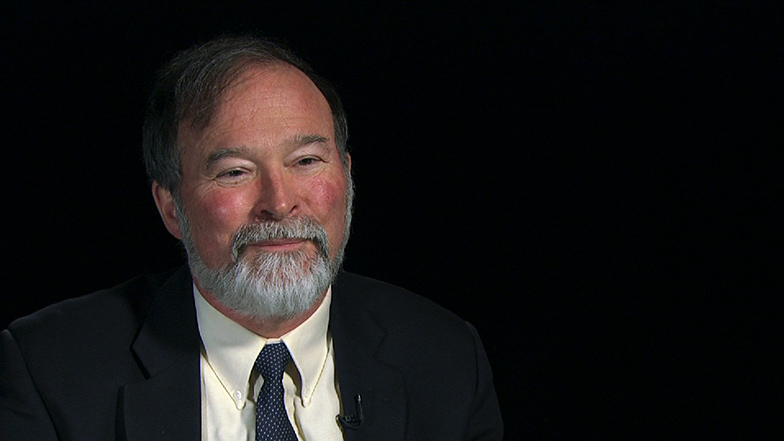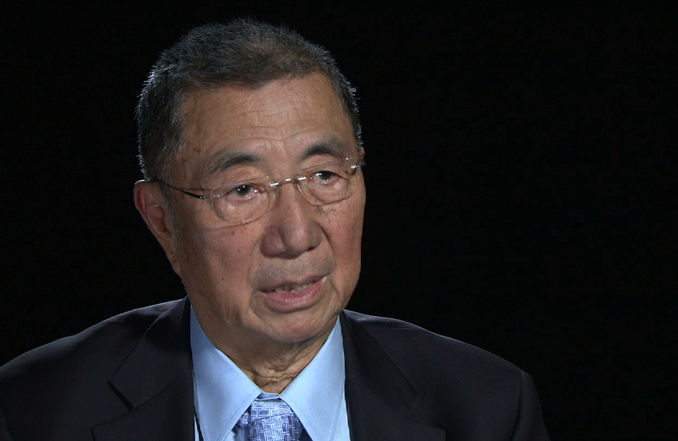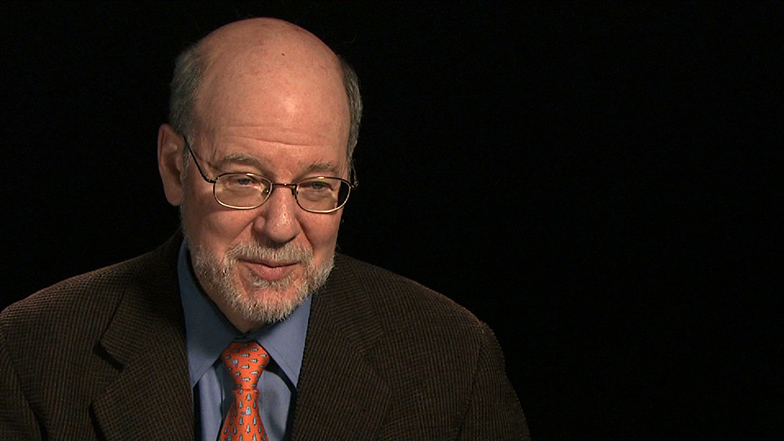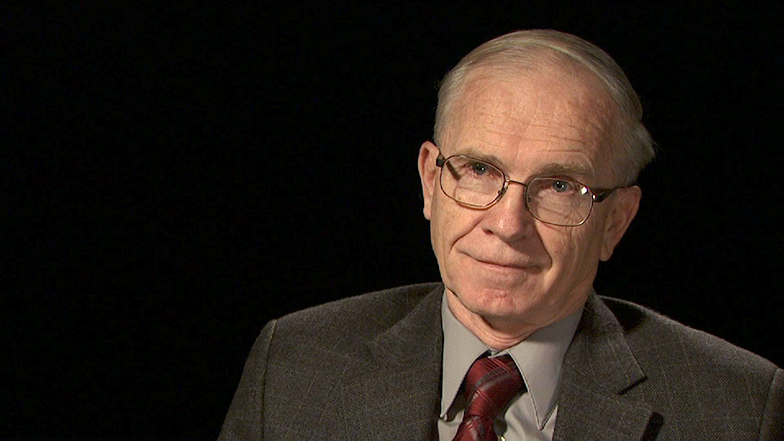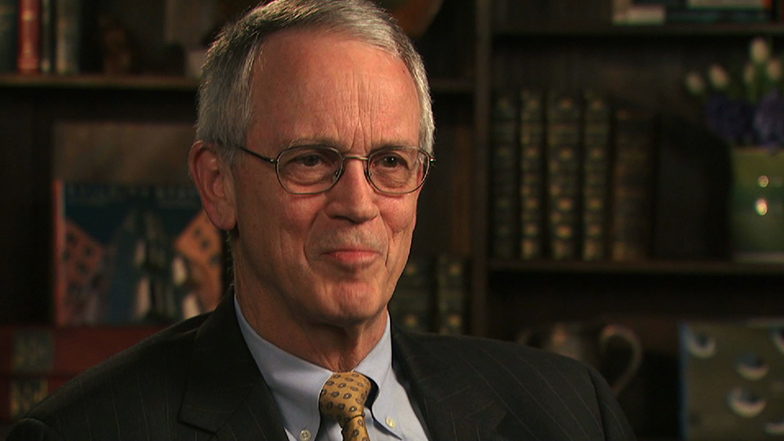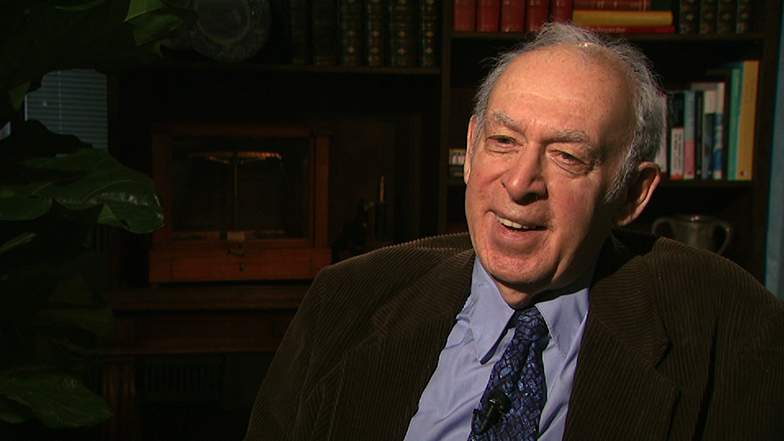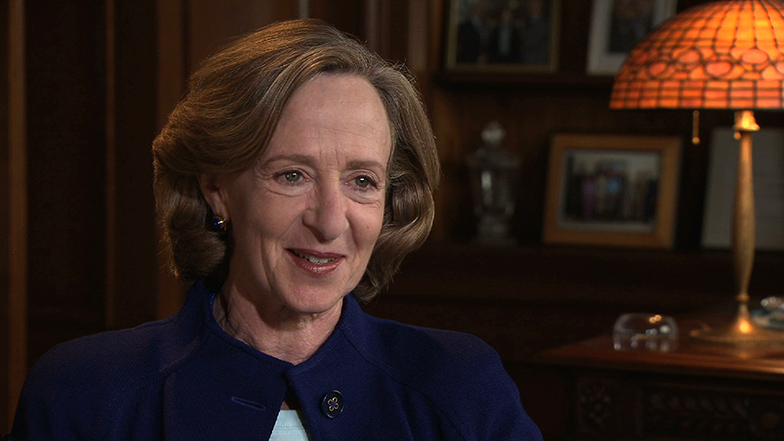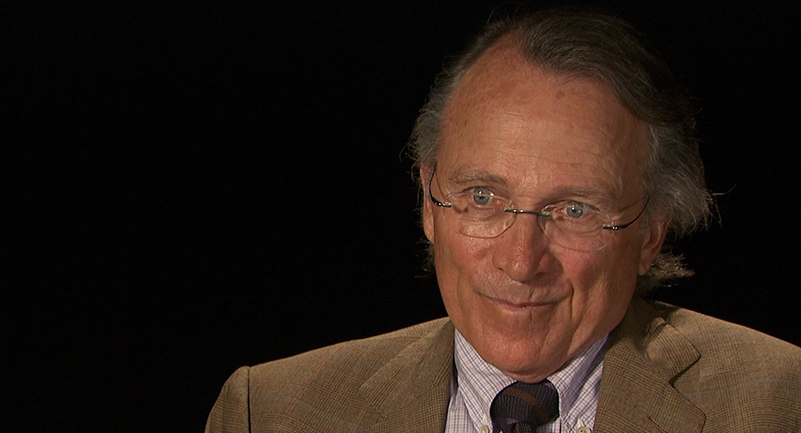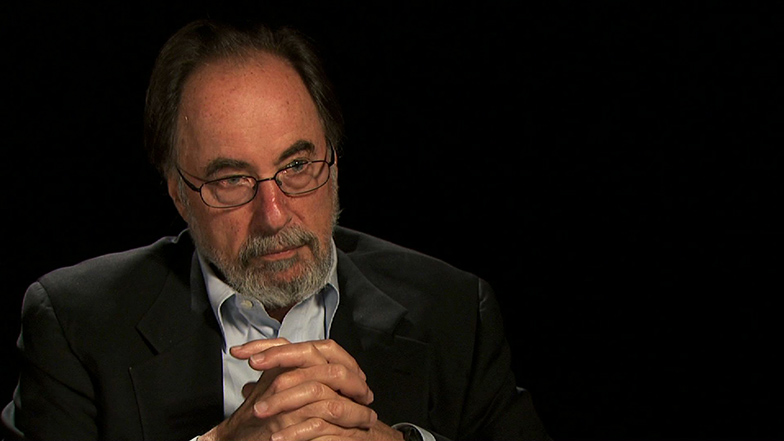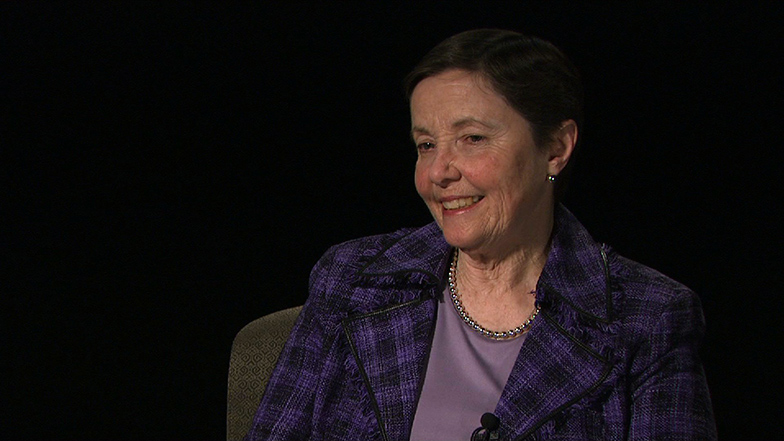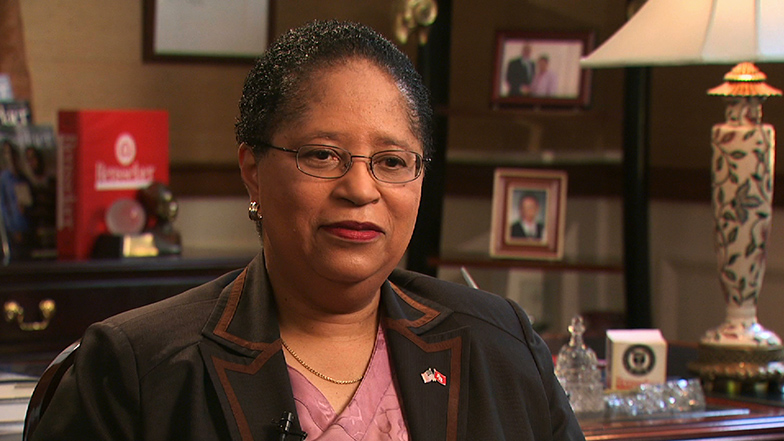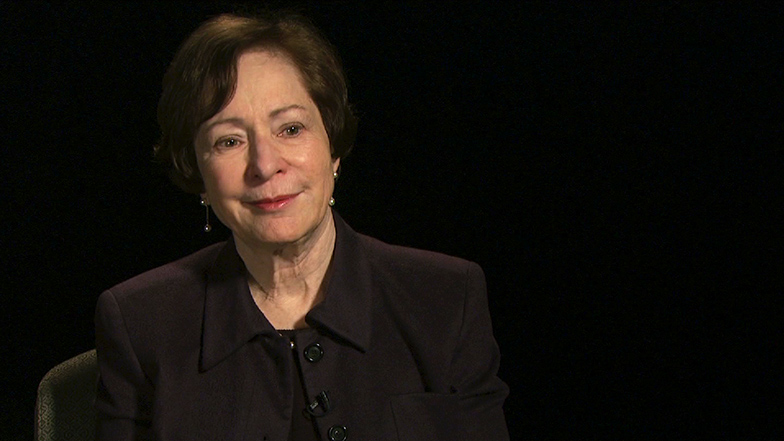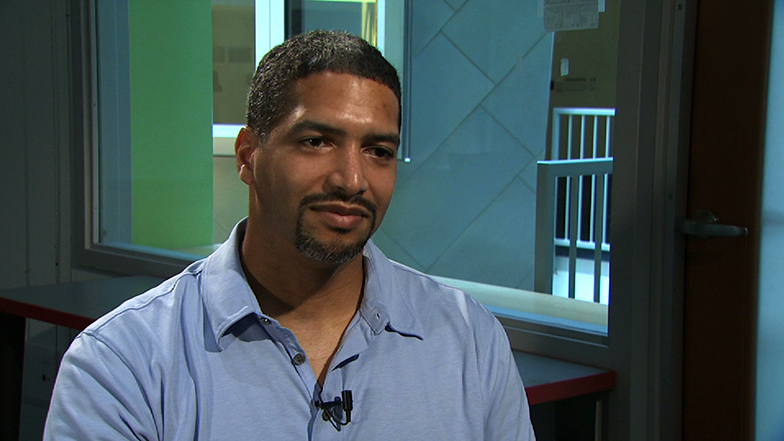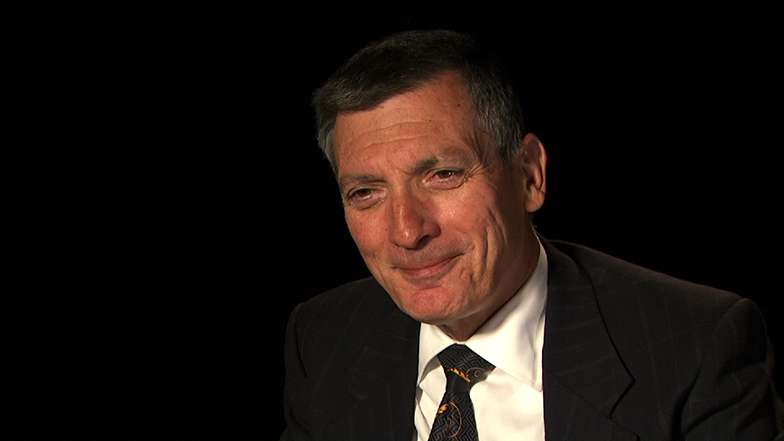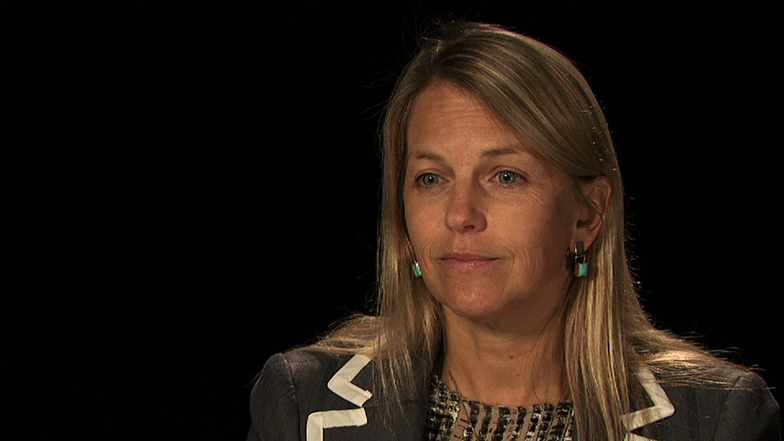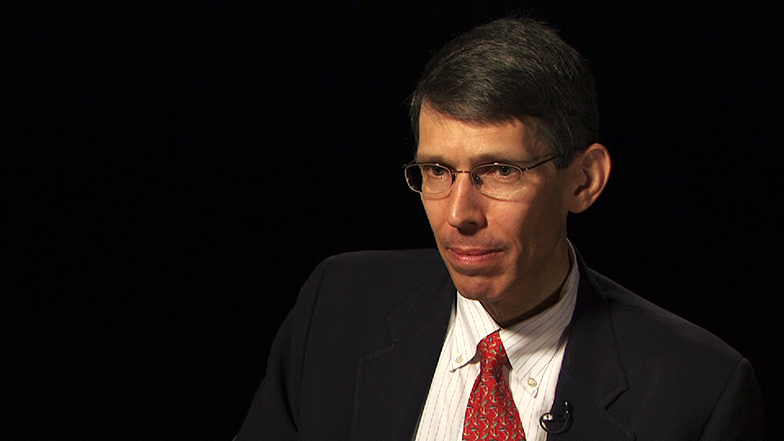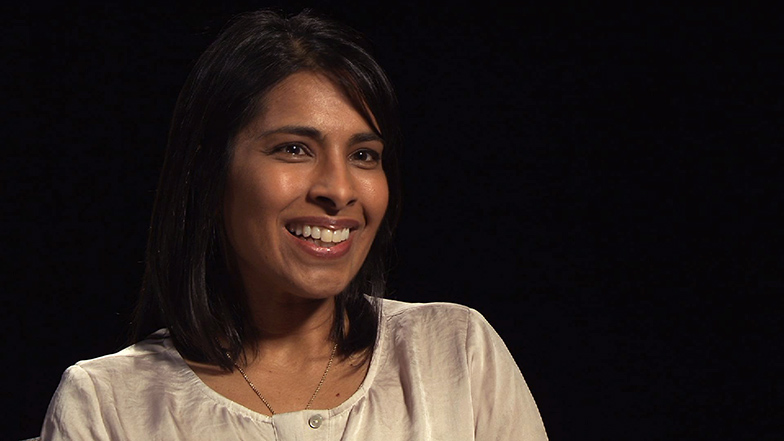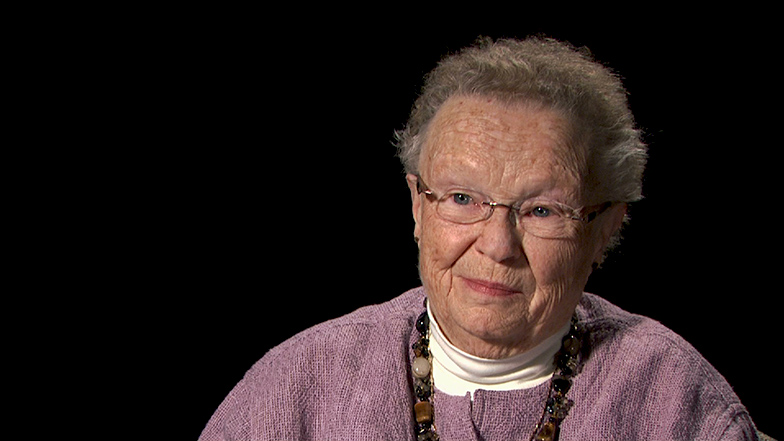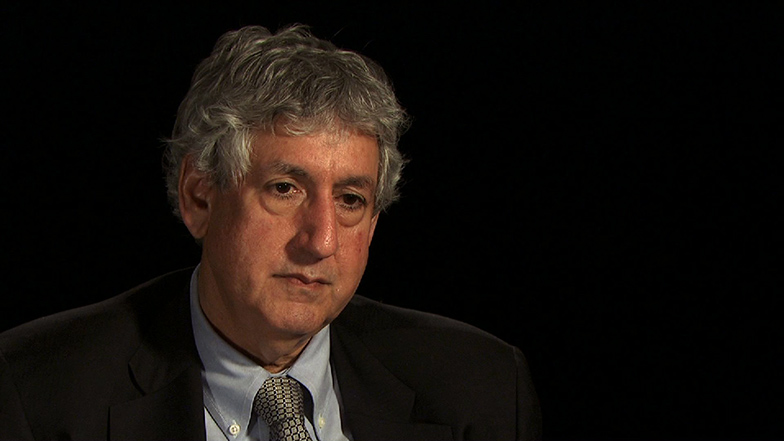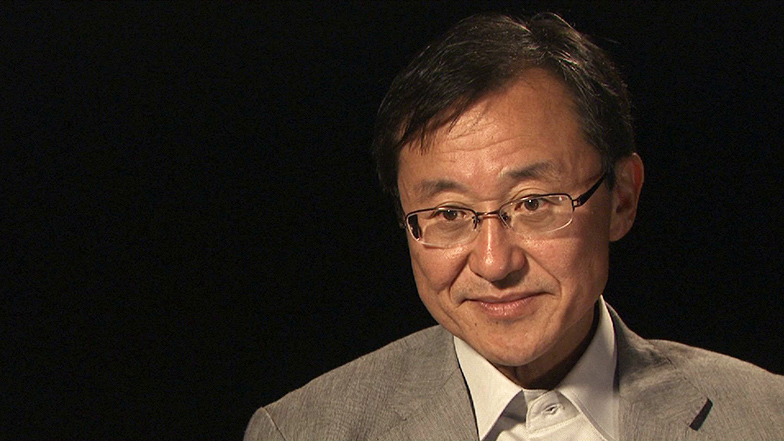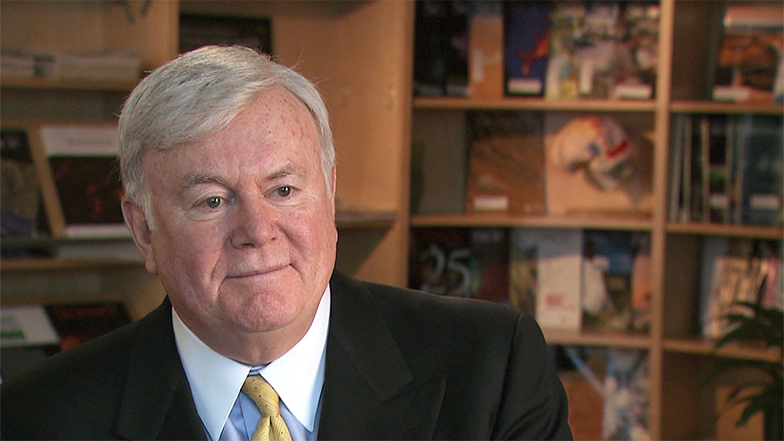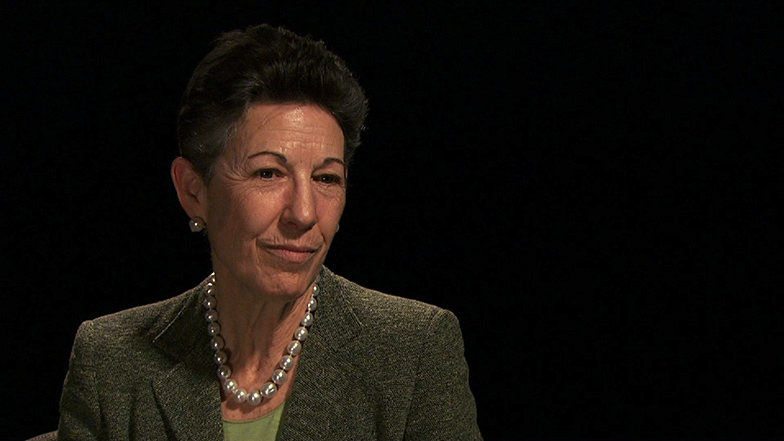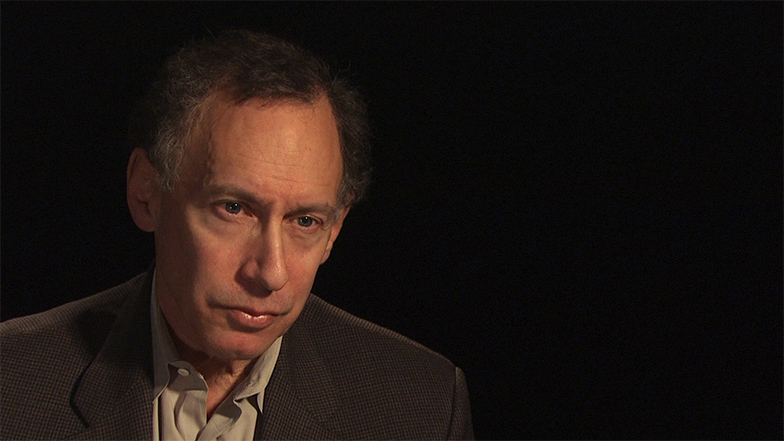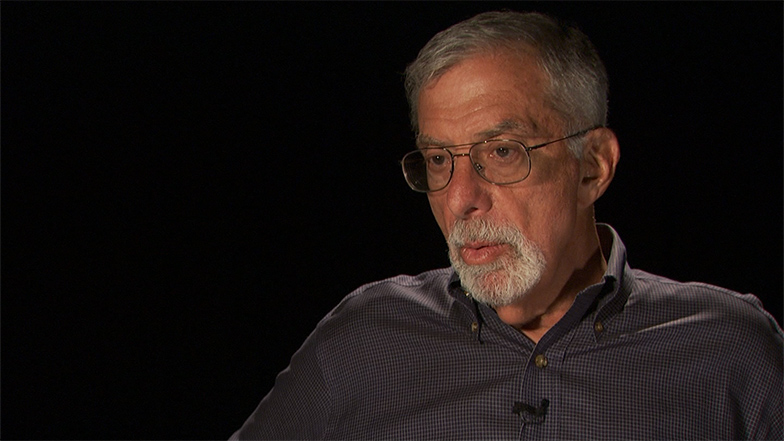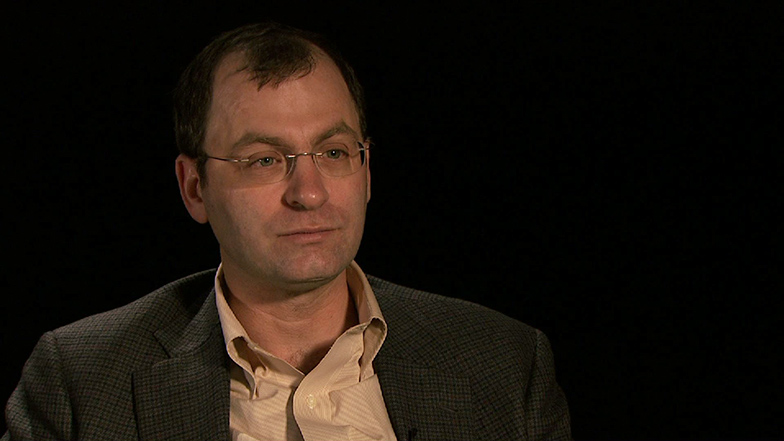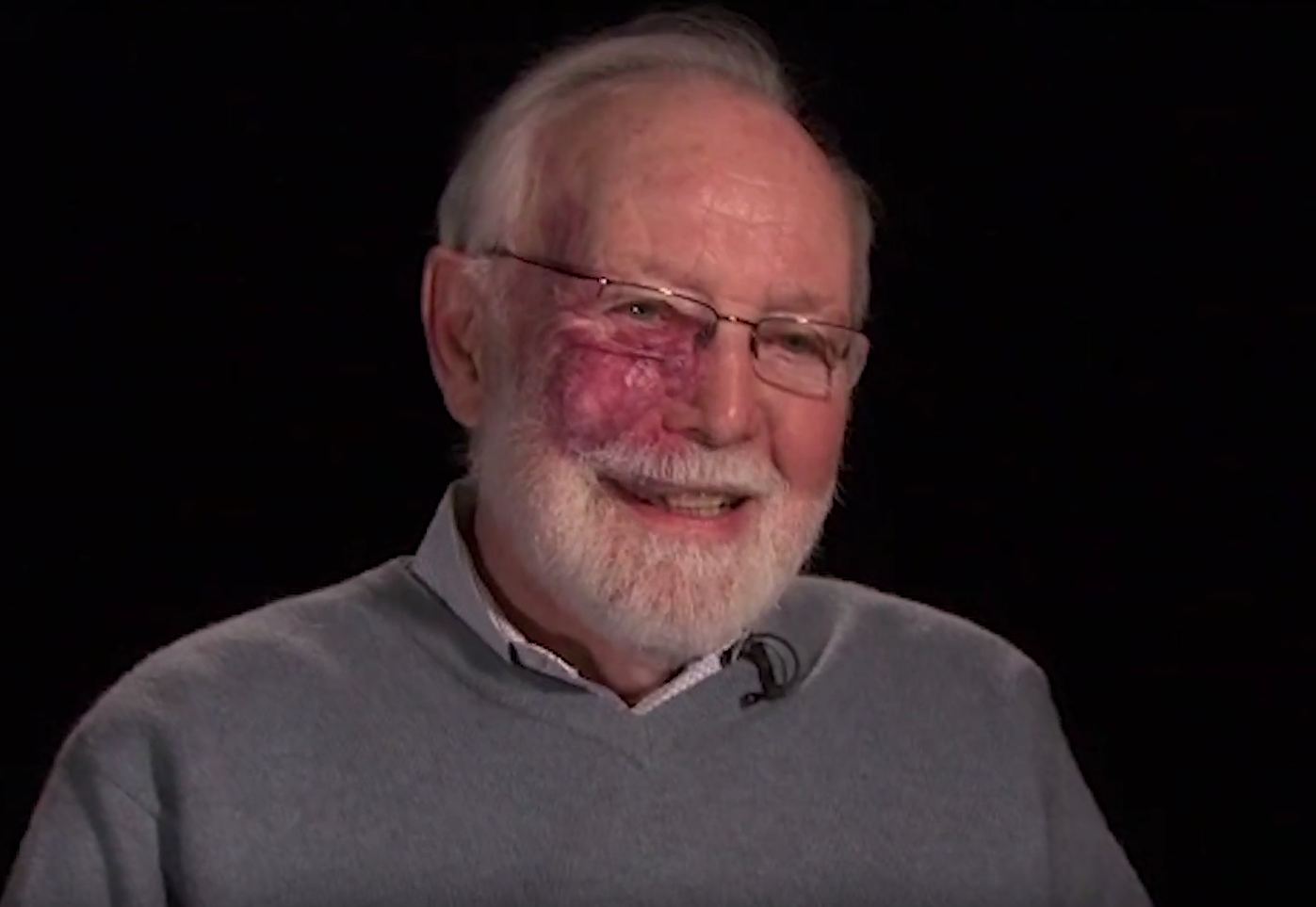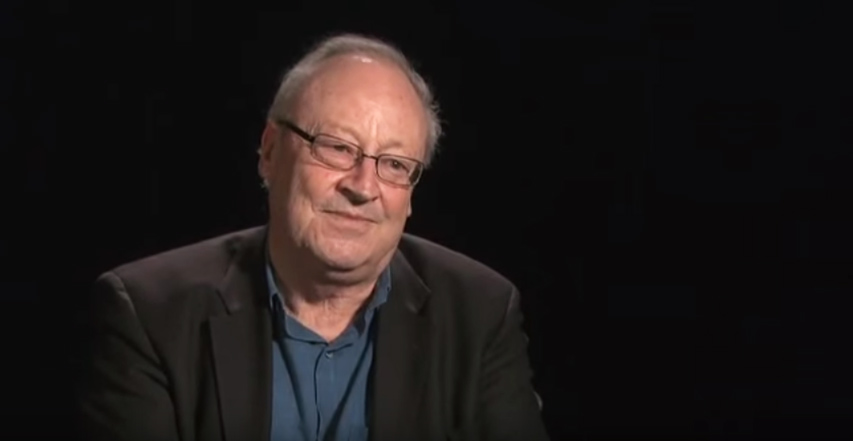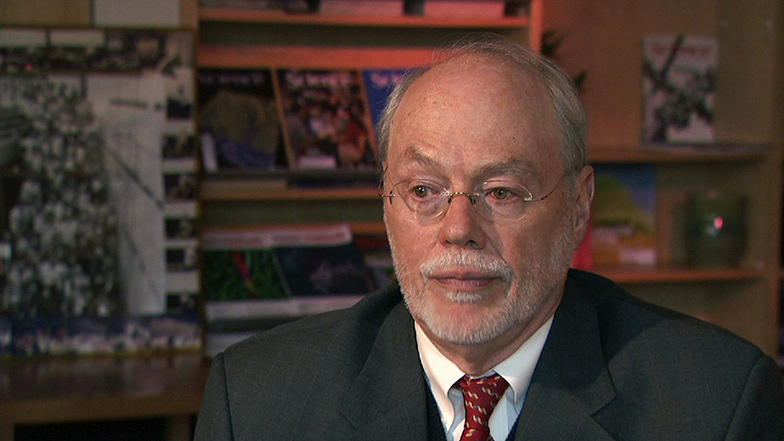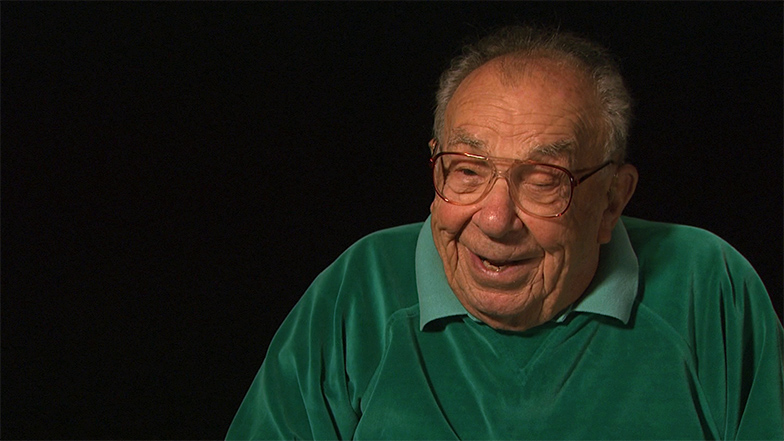Paula T. Hammond '84, PhD '93
INTERVIEWER: Today is December 12, 2011. I'm Chris Boebel. As part of the MIT 150 Infinite History project, we're talking with professor Paula Hammond.
Professor Hammond is the David H. Koch Professor in Engineering and the Department of Chemical Engineering at MIT. Her research focuses on the study and development of new materials based on the molecular design and synthesis of self-assembling polymers. Professor Hammond's numerous awards include, to name just a few, the NSF Career Ward, the EPA Early Career Award, the DuPont Young Faculty Award, and the 3M Innovation Fund Award. Recently the Harvard Foundation named Dr. Hammond the 2010 Scientist of the Year.
She's been a key research participant in both the MIT Energy Initiative, or MITEI, and the David H. Koch Institute for Integrative Cancer Research at MIT. She was also instrumental in the founding of the Institute for Soldier Nanotechnologies at MIT. Professor Hammond received a bachelor of science degree in chemical engineering from MIT in 1984, a Master's degree from Georgia Tech in 1988, and a PhD from MIT in 1993. She joined the faculty of MIT in 1995.
Professor Hammond, thanks very much for coming in to talk to us today.
HAMMOND: Great. I'm very happy to come talk.
INTERVIEWER: So tell me a little bit about where you were born and where you grew up, for starters.
HAMMOND: All right. I'm from Detroit, Michigan. I was born during the '60s, so it was a great time to be in Detroit. It was the time of Motown, among other things. And my parents are professionals. So my father was a PhD biochemist, and my mother was a nurse educator. She actually started a community college nursing program. So I grew up with my parents and my two brothers, one older and one younger, in Detroit.
INTERVIEWER: So your parents were in the sciences. Your father was a scientist, your mother was in a related profession.
HAMMOND: That's right. That's right. They were scientists involved in public health. And for that reason, I always was encouraged to explore science, math, as well as all of the broader fields of social and physical sciences.
INTERVIEWER: So talk a bit about your early education. What were the clues that you were interested in pursuing science and engineering?
HAMMOND: Well, when I was very small, I was interested in things like sticks on the ground. I'd pull apart leaves. I'd examine acorns, flip them open, try and look at how they were constructed. So I was always interested in nature and the things that surrounded me. I liked to examine the way sticks moved along a river, for example.
But when I was growing up, I was also a real bookworm. I loved books, and still do. But at that time I was reading a huge amount of children's literature. So I was inspired both in terms of writing and in terms of science. All the way through eighth grade, I actually was planning on being a writer. And even in the first couple of years of high school, I had decided I would be a writer of children's literature. And I participated in a few writing contests, and wrote short stories to myself, et cetera.
But when I got to my chemistry class in high school, I was able to work in lab. It was the first time I'd actually had a lab experience along with my class. And the idea of actually being able to make something out of two completely different things really compelled me to look at chemistry more closely.
INTERVIEWER: So you mentioned wanting to be a children's book writer, which is really wonderful and interesting. Did your parents, on the other hand, sort of assume or expect that you would go into the sciences ultimately? Or was this-- were they supportive no matter what?
HAMMOND: I think they were pretty open. In fact, when I was young I also took ballet and music. And I think I spoke a little bit about being a ballet dancer. I went through the writing period. And at that time, they were supportive of each thing that I latched onto. So I had a huge amount of support. My father did buy me a build-your-own heart kit. And I shared some of the chemistry kit that my older brother had. We did some of those projects together. So I was interested in that.
But I don't think there was a major expectation that I'd go into the sciences until I began to show a very strong interest in that direction. At that time my chemistry teacher told me, and also mentioned to my parents, that I should think about chemical engineering, which was a field that was relatively rapidly growing at that time but didn't have enough young people engaged in the field.
INTERVIEWER: So chemical engineering was kind of on the radar pretty early, almost as soon as science was?
HAMMOND: Yes. I became aware of chemical engineering in my junior year of high school and began to look at, track, and follow it. So at that time I knew I loved chemistry. I really enjoyed physics. I liked math. I felt math was a very natural thing. And at that time, chemical engineering seemed to be able to bring those things together.
INTERVIEWER: So you talk about being kind of a bookworm. Were you always academically inclined at school? I mean, even before the high school experience?
HAMMOND: Yes, I was academically inclined. I was the good student. I raised my hand a lot. I got good grades, and I tended to be very much engaged with my teachers. I tended to know my teachers very well.
INTERVIEWER: So talk a bit more about high school, and then your search for a college, and where you ended up.
HAMMOND: Once I knew that I wanted to go into engineering, I started to look at universities that were strong in those areas. And I applied to several places. But MIT always stood out as the place where you go if you're going to be an engineer. It was the number one place as far as I could understand from my perspective as a high school student.
I went to a small high school. It was called Academy of the Sacred Heart. It was a Catholic school. It was private, and all girls. So we had a very small group. There were 40 in my graduating class, which was larger than most of the other classes. I was the only one interested in engineering in that year. So it was a unique experience. A number of my cohorts were interested in pre-med, so we could have some conversation about how to use science and engineering. But I was the only one talking about chemical engineering. So I had to ask others.
My father tried to link me to people who were in related fields. I tried to read as much as I could about chemical engineering. At that time we didn't have the internet, so we weren't able to Google the field and really understand it rapidly. But from everything I understood, it would allow me to work with chemistry. And I really loved chemistry, and I loved the idea of being able to make new things. So that led me into chemical engineering, from that perspective.
INTERVIEWER: So you came to MIT thinking, first and foremost, chemical engineering was where it was at?
HAMMOND: That's right. I came to MIT. First thing I was thinking of was chemical engineering, and I stayed on that path. I was excited by the other fields that I ran into, but I always thought, I'll check that out while I'm becoming a chemical engineer. So it was always a part of it.
INTERVIEWER: So tell me a little bit about being an undergrad at MIT in the-- this was the early 1980s?
HAMMOND: That's right. That's right. It was scary. When I first arrived at MIT, I was a freshman. And I was a little bit-- I was maybe a year younger than the rest of my colleagues. So I was starting as a 16-year-old turning 17, and on my own. Which was exciting for me. I liked the on my own part. But the idea that I was surrounded by people who were such high achievers was scary to me.
I realized that I was not necessarily going to be at the top of the class all the time, and that was what I was used to. I was also aware that a number of my classmates had more training than I did. In my small, Catholic school, I learned a lot about standing up for myself in the classroom and feeling confident. And I'd gotten a good education in what I'd learned, but I hadn't gone as far in calculus and as far in physics as some of my friends who came from Brooklyn Polytechnic, for example.
INTERVIEWER: So did you find yourself playing catch up a little bit in those areas?
HAMMOND: I did. When I started in freshman year, I took all of the beginning freshman classes. I had to work harder than maybe some of my friends did because a lot more of it was new to me. Especially the calculus part because I hadn't taking calculus in high school. I actually had taken pre-calculus. So I had to really catch up in that category. I was seeing things I'd never seen before that my friends had seen at least once before.
And the same goes with some of the physics classes. But I had chemistry as a kind of solace because I got chemistry to the extent that it was just a very easy class for me, and I could feel a certain level of confidence in that area. So while I was struggling in three classes, I at least had a fourth that I could relax in and really be at home in.
INTERVIEWER: Were there professors within chemistry, or elsewhere for that matter, that you felt were either mentors or who were very, very memorable to you?
HAMMOND: One of my early professors who was very memorable was Kemp from the chemistry department who taught organic chemistry. And this was-- by this time I was in my second term of my freshman year. Organic chemistry was wonderful. I loved the class, but Kemp was also, he had a huge personality. He brought in these really exciting demos.
I remember when he was talking, I believe, about aromatic compounds and bringing in an entire beehive encased in glass, and talking about how some of these compounds are used for bees to signal. He talked about the different smells that you get from these different aromatic compounds. And it made the experience extremely real. So I definitely remember him.
I remember Professor Rota in differential equations in my sophomore year, who was prone to requesting a Coke. Students would come and leave Coke cans on his lectern for him during the middle of his lectures. And these are just a few examples of some of the really memorable lectures I had getting started.
And then later on, as I began to get more deeply involved in chemical engineering, the lectures that really stuck in my mind were those who taught the polymer science classes. Including Ed Merrill, who was an incredibly memorable lecturer, and made the physical chemistry of polymers seem as exciting as a play or a theater act, actually.
INTERVIEWER: It's interesting that you talk about organic chemistry being so exciting and comparatively easy, since it's a class that a lot of people founder on.
HAMMOND: Yeah. I love chemistry. I think it's one of the things that always gets me excited-- is the idea of how to put things together and how to control them so that you get what you want. And the idea of design and synthesis is one of the things that continues to drive the work that we do in my lab. So it's an exciting-- it's an exciting principle to build on.
INTERVIEWER: So in the early 1980s, the composition of the MIT undergraduate class was obviously quite different. There were comparatively fewer women. The ethnic diversity was less, although certainly people were aware of both of those things as an issue. Was that something that you thought about at the time? Were you concerned about it? Did it change your experience in any way?
HAMMOND: Yes, definitely. First of all, in terms of women, I think that there were-- one in six was the ratio of women to men at the time that I started at MIT. So that was pretty different from today's near one to one ratio.
But beyond that, there were probably I think 35 - 40 African American students in my class of freshmen in that class of 1,000 then entered. This was the class of '80, entering class of '80, graduating class of '84. And the group was really close. When you really are a true minority-- a minority of a minority, essentially-- you really get to know each other well.
So when I was in high school, I had a very broad range of friends across a very broad spectrum of backgrounds and race. While I was at MIT, I tended to have a much tighter cluster of friends who were African American. We all knew each other. We all helped each other out. And I think there was a strong need for us to find each other and support each other so that we could have the strength to continue to move forward, and to reinforce the idea that we could move forward. Especially given the relatively competitive background of MIT.
INTERVIEWER: So I mean, obviously, MIT is tough for anyone. Was it in any way tougher for women at that time, just in terms of being taken seriously by faculty or other students?
HAMMOND: Definitely. I think that at that time for women in general, there was a tendency to think that you probably didn't know the answer to the question. So there was an anticipation before you raised your hand, before you spoke, that the likelihood of your getting it right was probably low. And that can influence the way you approach things. It certainly can influence how often you want to raise your hand.
I think that also strongly affected those of us who were black at MIT. Because you're sitting there as maybe one or two other black students in the classroom-- maybe you're the only black student in a recitation-- and you're surrounded by people who have a very strong sense of confidence-- even if they don't have it inside, they're conveying confidence on the outside. So the ability to be able to raise your hand and put yourself out there, and perhaps get slapped down, is something that becomes a much greater risk when you're out there by yourself.
So I definitely sensed that. But beyond that, I was fortunate because I didn't have any direct conflicts with other faculty members. But I had fellow classmates who made comments to some of my own friends about whether or not they belonged at MIT. So there were both subtle and non-subtle cues that were given about whether or not you belong and whether or not you're expected to excel at the same level.
And those things exist, I think, but they definitely existed much more at that time than they do now. It's really interesting though to--- when you look back, think about how easy it is to give those cues and perhaps not even be aware that one is giving them to young people. But there's an expectation that you don't necessarily know what's going on, or you may not necessarily be the one who will hit the top of the class in terms of score.
INTERVIEWER: This is something-- we'll probably sort of go chronologically, and eventually I think it would be very interesting to return to this from your perspective as a faculty member. But just in general, do you have the sense that students now are more aware of those issues and those kinds of cues? Or do you think it's still an issue to a degree?
HAMMOND: I think it will always be an issue as long as there are differences. But we've gotten much better at it. I think at MIT, in terms of the undergraduate population, students' interactions with each other for the most part have improved. People have a greater understanding and appreciation for differences and are less defensive about the idea that there's a past here and we're getting beyond that past with regard to how we look at race and gender.
I think when I was at MIT, although there were a number of people who were open minded-- and we were so blessed to have people like that around-- there were a number of people who wanted to feel they weren't biased, nor had they ever sort of practiced any form of bias. And I think that's too hard to do. It's too hard to expect that you will never have participated in some form of bias. I think it was very difficult at that time for people to have a conversation without becoming defensive.
Now I think it's easier to have those conversations, especially with our students. Although it's more difficult as we get to older generations, it's something that I think we've become much better at.
INTERVIEWER: So one of the things that is a real hallmark of an MIT undergraduate education now is the opportunity to do research as an undergrad, real research. And I was wondering, was that something that you enjoyed at that time? Or has that changed at MIT? Are there more opportunities now?
HAMMOND: I definitely felt as an undergraduate that we were encouraged to take part in undergraduate research. The MIT UROP program was famous already. People came with the expectation that they would get some opportunity to take part in the real research experience at MIT. So I think that even on arriving, I was looking at whether or not I could do a UROP, when I could put it into my schedule.
And for me, that time came in my late sophomore and early junior year. I began to do a UROP project in the Cooney Lab in Chemical Engineering at MIT. And it was based around a bioreactor idea. But in general, I would say most of my colleagues in my field did do UROPs at some point. Now I think it's even more of a routine situation that a freshman will take a UROP, or a sophomore will take a UROP. And I think that's great. In my own lab, we have a number of very early undergraduate researchers.
INTERVIEWER: So talk a little bit more about that initial UROP experience that you had. Was it exciting to actually get in there and do research?
HAMMOND: Definitely. I think one of the things that was exciting was that you have a problem that has no set solution. So now you're actually able to look at something, examine it, and see what comes back. And you're finding out at the same time that your faculty member or graduate student that you're working with is finding out. And that puts you in the same spot. You're shoulder to shoulder in terms of observing science together, and there's a very powerful thing about that. About examining something, understanding what you're finding from your data, and having an opportunity to discuss and analyze it with these excellent peers and research supervisors.
So I think that was one of the strongest things that I had, that and the fact that I had to build my own reactor. So I actually had to go in the glassware catalog and look at how I could couple things together to build a reactor. And seeing that become a real thing, going to the glassblower, having it made, that gave me a big sense of accomplishment. I designed this, and look-- it works.
INTERVIEWER: So as an undergrad, especially in the later years when you were taking on those kinds of challenges, what kinds of problems or challenges did you find really exciting? I mean, if you were thinking about your career ahead at that time, what did you imagine you might be doing?
HAMMOND: When I was an undergraduate, I was still trying to figure out where I could really exercise chemistry as a chemical engineer. Because one of the things I was learning was that chemical engineers were indeed as exciting and great as I thought, but they weren't all involved in manipulating molecules to make new molecules. And that was the part of me, the chemistry part of me that I wanted to fulfill. So I began to look for where I could find that thing more directly.
And when I took the polymer science classes, they were really graduate level classes, but you can take them as an elective as an undergraduate. I found that here you can actually design a molecule-- big ones-- and they can form these exciting new materials: plastics, polymers, a range of different kinds of functional materials. And that intrigued me. So although I later on went to work before I went back to grad school, the idea of working with materials and making polymers really stuck with me. And I thought, this is something that allows me to use my mechanical engineering skill set, but I get to use my organic chemistry. And they become my tool, a part of my tool set.
INTERVIEWER: So what is a polymer?
HAMMOND: A polymer is a large molecule; it consists of a constantly repeated molecular unit that is attached. So you have this repeat unit many times, and you have a chain-like molecule. And there are some natural polymers that we're used to seeing or hearing about all the time-- polysaccharides, polyglycerols-- that exist in our body. There are also synthetic polymers, we hear them all the time-- polyester, polyamide, which is essentially nylon-- which make up the textiles.
But there are a range of polymers that we work with in our lab that are designed either for function relevant to energy applications or for biomedical applications. And that's where things get interesting. You can design any of these long chain units so that they form a substantive material that has a given property.
INTERVIEWER: And your original interest in polymers stretches all the way back to your undergraduate years.
HAMMOND: That's right. Absolutely. Absolutely. When I first began to take these classes, I thought, this is nice. I could really get into polymers. And at that time, I think that remained in my mind. And some time later when I saw that a program for polymer science was being started at MIT, that also attracted me.
INTERVIEWER: So as you were in your last years as an undergrad at MIT, talk a little bit about your thinking about the future, what you wanted to do, where you want to go, and then ultimately what decision you did make after you graduated.
HAMMOND: That's right. So I was approaching graduation, and at this point I had just turned 20, this was my last year of college. I was engaged and was thinking about graduate school, but wasn't certain about whether I wanted to go to graduate school for that full time scale. If I was going to study polymers, or-- what was I going to do? And at the same time was interviewing for jobs. And my fiance was also interviewing for jobs, was also from MIT. And we decided that we would work and see what that was like.
So I ended up becoming a process engineer at Motorola in Fort Lauderdale, Florida, which is not a bad place to go. So I went from Detroit to Boston to Florida. And this is my first experience being in the South, my first experience being in a place where it was warm all the time. But it was also my first experience as a real life process engineer. And I spent two years in Fort Lauderdale working for Motorola.
We were responsible for the part of the line that packages the chips that go into pagers, which of course now is a little dated. But at that time, pagers were the new thing. And the first cell phones had been introduced to the market. And this was part of the communications sector of Motorola.
INTERVIEWER: So talk just-- I'm just curious-- a little bit more about that decision to get your feet wet in industry, doing things, rather than going on immediately to graduate school. Talk about that decision, and also what that meant or why that was important.
HAMMOND: I think at that time I wanted to have a better understanding of what I wanted to do long-term in life. And I also wanted to see what it would be like to be a quote unquote real engineer, what it would be like to actually have a major part of a product depend on me. I had done some summer internships; one summer internship was in an R&D facility at Dow Chemical. So I knew what the R&D side looked like. I hadn't really done anything where there was a huge amount depending on me. So I thought this would be an interesting way to see how engineering applies in the field. It would also be an opportunity to see what aspects of engineering are really appealing to me, and where I excel.
So I went to Motorola. I was a process engineer, which meant I was the first up on the line after the factory supervisor. And I was assigned a part of the line that was my area of responsibility. It had three shifts. I had a pager and they could reach me any time.
And what I found was that I was spending a lot of time taking care of little problems that really messed up the entire line. So I would have to run out-- we called it firefighting. I'd have to figure out what was wrong, why this particular process wasn't working or wasn't working well, and work with the supervisor on the line to see if we could fix that. So I found that there is a lot of this job in which I could learn a lot about dealing with people and dealing with equipment, but I didn't have an opportunity to change the process permanently.
So at that point, I found I've learned a lot. I did learn how to implement new processes. I implemented two processes at that time to try and improve the rate at which we could generate product. But for real impact, it was important to be able to make more major changes. And I became interested in how I could do that and found that that would require getting a Master's degree, becoming more engaged in process engineering.
At that time, I thought, this is a good opportunity to go back to school and also to determine what I really want to do. Maybe it's not even process engineering. Maybe it's engineering the product, the system itself.
INTERVIEWER: So not to sort of create a one size fits all model, but do you think it's important for engineers to have some quote unquote real world or industry experience?
HAMMOND: I think if an engineer can do that, it actually improves their ability to assess not only what they want to do, but also whatever they choose to do. It gives them the ability to get a real world perspective on a problem, to understand what's important. Because even now when I have conversations with people from industry about a development in our lab, one of the things I think about is manufacturability and processability and cost and scale. And those are things you really learn rapidly if you have an opportunity to do this.
I do think it also gives you an ability to gain confidence in your ability to lead others and to lead a project. Because you have this corporate entity that is counting on you, and you really can't turn away from that. So I think it actually is a great opportunity.
And there are different ways one can get that experience. I did it by working for two years. But there are also programs and internships at companies. Our own department has a chemical engineering practice degree that gives you some of that. So it's nice to see if it's something you want to explore, especially if you're wondering where you really fit in terms of the engineering and science field.
INTERVIEWER: But ultimately, you did decide to go back to grad school.
HAMMOND: Ultimately, I did. When we finished that two year stint at Motorola, my husband started working on an MBA at Emory in Atlanta. So I moved to Georgia Tech Research Institute, where I was working full time, and started working on a degree part time-- a master's in chemical engineering at Georgia Tech. So I became a Georgia Tech Yellow Jacket during that time period. And my boss was a PhD polymer scientist. I worked on a polymer science research project, or a series of research projects, one of which became the basis for my master's thesis at Georgia Tech.
And at that time, returning to a campus was a huge revelation for me. Because I realized I wanted to remain on a campus for the rest of my career. At that point, I realized going from one situation to the next, that the campus was where I could actually lead my own ideas, develop my own research tool set, and choose my own problems.
INTERVIEWER: So tell me-- and I'm scared to ask this question because you'll probably lose me very quickly-- but tell me a bit about the work you were doing as a graduate student at Georgia Tech. What kinds of problems were you engaged with?
HAMMOND: One of the things I was working on was a polymer based robotic tactile sensor. The idea was to take a polymer, like polysiloxane and introduce silver micro-particles into the polymer dispersion so that when you exerted a strain or a stress on the sample, the resistance across the sample would change. And if one were able to create small pads of these tactile sensors in an array, you could actually develop something that would detect for a robot what it was touching and where.
So this was the general idea of the project. I was working for Georgia Tech Research Institute. And my boss, Jan Gooch at the time, was leading this project. So I came on board and began to investigate this. And this became the basis of my master's thesis. And my master's thesis was advised by professor Avi Averamen at Georgia Tech's chemical engineering department.
INTERVIEWER: So ultimately though, you ended up coming back to MIT to do your PhD. Can you talk about that transition?
HAMMOND: Yes. I really had a great experience at Georgia Tech. It was my opportunity to become, I think, a researcher. And I was incredibly motivated there. I had great interactions with my fellow master's students. We shared a lot. I learned a lot about my own background at MIT, which was a little bit more theoretical, and some of their backgrounds, which were more practical. And that combination really fortified me. But I was always thinking about MIT in the background.
I think I missed several things about MIT. One of them was the fact that, at MIT, there is this huge diversity. It's hard to replace the diversity that you have here, with regard not only to race and gender, but also to international origin, culture, et cetera. And the thing about MIT is that these things are so obvious, they're celebrated, they're thrust in front of you. So when you walk down the hall, you have the Chinese Club selling you something, or you have this group of people who love juggling doing things on the side.
This mix of interest, and nationality, and culture always got me excited when I was at MIT. And I did miss it in the other places I had been since. On top of that, MIT is special in the sense that you can sit at the top of a mountain, so to speak, in one department, but if you reach to the left and the right and you don't have extremely strong partners in other departments, then you're not able to do as much. At MIT, it feels as if there's no limit because everyone is sort of at the top of their field, regardless of the field they're in. So you can find a top person to work with you and to collaborate with at MIT, and certainly in the surrounding environment of MIT and its neighboring schools. That was a special thing about being here.
But probably the thing that I missed the most about MIT was the fact that you could actually walk down the hallway at any point and feel a sense of excitement, this kind of buzz going on. And I didn't find that anywhere else.
INTERVIEWER: And Boston, you like Boston? You like the Northeast?
HAMMOND: I love Boston. I really love living in the Northeast. I like the--- again, the diversity, but also the sort of geographical scrunched up nature of Boston, which brings people together in a unique way. I like the fact that we have neighborhoods then you can walk in the span of 10 minutes that change dramatically in the next 10 minutes. I love the people. There's a kind of very deep character to the people in Boston-- they're tough people. They're not always approachable, but they're usually approachable. And I think I like that about the folks in Boston. They expect a lot from each other, I think, and it actually generates an atmosphere where you stretch yourself.
INTERVIEWER: So tell me a little bit about your PhD work then when you were here.
HAMMOND: Sure. So when I joined MIT again, I came as a part of the Program for Polymer Science and Technology, which had been started two years earlier by Bob Cohen in Chemical Engineering. And in that program, you can actually choose your adviser from any of the departments as long as that adviser is a polymer researcher. So I got to choose Michael Rubner, who was in Material Science and Engineering. He was working on a range of very interesting functional polymer systems that had electro-optical applications.
What I found fascinating was a project that he had in which you have a group called a diacetylene group. It's really a carbon carbon triply-bonded connected to another carbon carbon triply-bonded. That diacetylene group, when it's exposed to UV light, undergoes a solid state polymerization. So if you have the diacetylene in something like a polyurethane and you expose it to UV light, it actually polymerizes within the polyurethane. Because it's got all of these double bonds-- the final product is a double, triple bond alternation, all of these are pi- orbitals through which electrons can move back and forth-- it absorbs in the visible light range. So it's got this really deep blue color. But when you apply any kind of stress to that backbone, it will change the ability of those electrons to move back and forth.
So in my project I was making these polyurethanes, which are rubbery materials that we're used to working with. And if you stretch them, they actually change color from blue to red to yellow, and then you release them and they go back. So this property of mechanochromism was something that we could study and actually examine the nature of the bonds within the polyurethane. So this became interesting for mechanal sensors and a range of other systems.
I began working on a temperature sensitive version of this based on liquid crystals. So I began developing a liquid crystalline polymer that had the diacetylene group. It was a polyester. And when you heated it up, it would change colors reversibly in the same fashion. And this was based on the idea that now you have polymers, but the polymers have rod light sections that stack together. And when we heat them up, those rod light sections become disordered and twist the polydiacetylene chain, causing the color change. So that was really the basis of my work as a PhD.
INTERVIEWER: So you got your PhD in 1993, I think it was from MIT?
HAMMOND: That's right. Exactly.
INTERVIEWER: Then what?
HAMMOND: All right. So when I got my PhD, because I entered knowing that I wanted to be in an academic setting, I had already been talking with my advisor about what it takes to become a professor, what kind of path I need to set. And in my last year as a PhD, I had started interviewing for faculty positions. I interviewed at a few places, and MIT was one of the places that made me an offer. I was extremely excited about the opportunity to start a career at MIT.
One of the things that was suggested to me as I was given the offer was that I take a postdoctoral appointment for a year or two and learn some skills outside of the MIT environment so that I could come back with a new skill set. Especially because I had an advisor, a research adviser who was already here, and a set of research skills that still closely matched things that were already at MIT. So, go away, learn something new, come back, and introduce those new things into your new research program.
So what I did was a postdoctoral study with George Whitesides at Harvard University in the Department of Chemistry. And this was an opportunity for me to work in one of the most well known groups in the field of chemistry in general, in the field of science. It was known for putting together people who think differently, quite honestly, about how you assemble materials, how you generate new material systems.
So at that time, they were working at self-assembly, and some of the early concepts of self-assembly. They were also working on applying what we think of as more common ideas like printing and other kinds of large scale assembly and applying that to chemistry, molecular scale printing. And they developed a technique called microcontact printing in which you can take a polymer- based stamp that has micron-scale features, instead of our usual, mini millimeter scale features. And these tiny features are the size of what we might see in electronic chips, for example. We can stamp chemistry by placing chemistry on the stamp and then transferring it to a substrate. And if we have a chemical bond that forms in that transfer, we can make a permanent pattern.
So I was working in George's group on using these permanent patterns to direct electrochemical deposition on substrates. While I was in George's group, I also began to think about a new technique of building film based on charge, which had been introduced around that same time, called layer by layer assembly. Which involves alternating positively and negatively charged species to build film. And my own research advisor had begun to look at this is as a way to control thin films.
In George's group, I begin thinking about whether we could use the micro-contract printed chemical patterns to control whether a film deposits on the surface, and if so, where. And in doing so, I could create patterns of these layer by layer films that were micron scale. And that became the focus of my research when I started my academic position at MIT.
INTERVIEWER: So not to ask a question that might be sort of too broad to be even meaningful, but did you detect, or did you see differences in the culture and how science was done between Harvard and MIT? And you can extend it even to Georgia Tech, if you want to.
HAMMOND: Oh, yes. Yes. I think I definitely experienced what I call culture gaps that I had to work with in each of the different places. I would say the biggest contrast for me though, was going from a chemical engineering department at MIT to the chemistry department at Harvard. There were several layers of differences in terms of culture.
Perhaps one of the biggest ones was that in engineering departments in general-- at Georgia Tech and at MIT-- we do a lot of exchanging back and forth. There's borrowing equipment here and there from the person who's working on this project or that project. And certainly that was true at MIT. The graduate students all knew each other, and we helped each other out all the time. I did liquid crystal measurements in the Cohen Lab even though I was in the Rubner Lab. I had a friend at MIT in Chemistry who actually let me into the NMR Room, which at that time required special permission if you weren't in the Department of Chemistry. And he would actually help me with NMR measurements.
So I found that at Harvard, there's not quite-- it's a different culture. Groups take care of themselves, but there's not the same sort of open sharing arrangements, at least not in the specific chemistry field. This may be a little bit different in the engineering side at Harvard. But I definitely experienced that as a cultural shift. I found that there's also a cultural shift with regard to being in any chemistry group and any engineering group. This is just one of the differences that makes life interesting.
But the culture in engineering is, of course, to think about how to apply your science and apply your work. But there are also these other subtle differences with regard to how we think about our science, and how we think about approaching problems. And I think in the field of chemistry, there's more pressure in general in delivering something that is incredibly beautiful, even if you've not exhibited 100 percent its function. And this has a little bit more to do with the origins of the two fields. In one case perhaps, the pursuit of knowledge itself to extend our science, and the pursuit of engineering to apply that knowledge and turn it into technology.
I was lucky because I was in a group, in the Whitesides group. George had a strong affinity toward engineers, and chemical engineers in particular. And he loved the idea of mingling these concepts together. So I was in a group that appreciated me and the way that I thought, and I was learning from fellow chemists, my new cohorts, how to think about a problem in a way which allows the elegant solution. So I think there were some definite cultural differences.
And then there's MIT and Harvard. I think it's fun to point out the differences there. But I found that when I was invited to a study break at MIT by undergraduate students, I would go and we'd have the pizza in the basement of the dorm, and that would be that. When I was invited to a study break by my undergraduate researcher at Harvard, it was a beautiful room looking out at the river. We were served tea. And we had a nice little piano playing in the background, and passed hors d'oeuvres. So I think that there are some cultural differences in how we socialize, how we get together. And I was amused by that, it was always very interesting.
INTERVIEWER: So after a couple of years up the river, you came back to MIT and began your career as an assistant professor.
HAMMOND: That's right.
INTERVIEWER: Talk about that transition.
HAMMOND: That was an interesting transition. It was interesting in part because I was returning to MIT once a student and now a professor. I was surrounded by people who had been my professors in classes, and I had to go from the professor basis to the first name basis. And adjusting who I was relative to everyone else was something that requires a little bit of check and recheck every now and then. But it was also a very embracing experience because this was a campus that was so familiar. And I felt that I had so many roots in the campus that there was no sense of limitation.
I think things had come full circle from my first appearance at MIT, when I was scared to death of everyone else and how I could possibly achieve on a level close to anyone else. And in coming back, I felt that I was returning to a group of people who would be future friends and colleagues working on incredibly exciting things and that I'd finally get a chance to really engage with them, to play with them, with a number of these science ideas.
INTERVIEWER: So in terms of teaching, had you had by that point a great deal of teaching experience during graduate school? Or was teaching something-- kind of a new challenge for you?
HAMMOND: Teaching was a new challenge. I think I had some teaching experience. I was able to guest lecture some of Michael Rubner's classes as a graduate student. And I also took part in a couple of the lab experiences, but I didn't have a TA. Somehow I missed the TA experience during my time at MIT. So I never had that day to day lecture experience.
And there's a big difference between preparing one or two excellent lectures on a specific subtopic and actually teaching the entire class. When you teach the entire class, that one hour of lecture, the first time you prepare it, can take you three, five, six hours to prepare. And you're doing that every time you give a lecture. So if you have a three lecture a week course, you're essentially losing huge chunks of days trying to put together a lecture that's cohesive. And of course, this is when you know the material very well. When you're teaching new material, it can take even longer. You really need to delve into new material, what's in the literature. It can be pretty extensive.
INTERVIEWER: Did you find that you enjoy teaching? Or do you enjoy teaching?
HAMMOND: Yes, yes. I definitely enjoy teaching. It's exciting to get students excited about the topic, about what you can do with the science that you're teaching. And of course, my favorite classes to teach involve polymers. So being able to convey the power of what you can do with these material systems is something that is incredibly important to me.
In general, I really enjoy having freshmen. I've taught freshmen, the Introduction to Chemical Engineering class. Being able to introduce them to the field in general. And I've also had juniors and seniors in a lab class. One of my first classes was actually a lab class, and that is a great experience, too, because you get to see them discovering things. You get to see them laugh for the first time when they see how a material moves, actually moves in your hand. You can see them kind of checking out what it feels like to handle the lab equipment. And there is a sense of discovery there.
INTERVIEWER: So around the time you started at MIT, or not too long after, there's a great deal of discussion and debate about women faculty and disparities in all sorts of areas-- lab space, and so on. Was that anything that you felt you had experienced at the time? Or what was your kind of experience with that?
HAMMOND: That's right. That report, the Report on Women and Science at MIT, I believe was released in 1996 or '97. '96, I believe. And I had been a faculty member for about a year and a half when it was released. And that report was incredibly revealing because it had actual numbers, and it looked at faculty who had established themselves so clearly in their field-- a number of them in the National Academy, for example. I do think that it focused on senior women, and that was why we could see these very clear differences in their space, in their compensation, in their responsibilities.
So it had a real impact on me. I definitely followed it. But at that time, it was at first too early for me to have experienced any of those things because I hadn't reached a point in the field where I could look around me and see any of those differences.
But also, I was I think very lucky. My department had already hired three women before me. And one of them was my mentor assigned to me. One of them has become a close friend and collaborator of mine. And all of them were great examples of, I would say, three very different ways to be very successful as a woman at MIT and a faculty member. So I had these examples in front of me. I had huge support from my own department. I actually felt strongly supported by every member of my department, the more senior and the very junior ones. So I think that's a unique feeling to have.
For that reason, I followed the report closely and felt I, or saw that I was positioned well with respect to having mentors. Positioned well with respect to having an environment where I could grow. And it simply gave me a sense of satisfaction that MIT can recognize that it's doing something wrong and change course.
INTERVIEWER: So we will be pausing briefly momentarily, but talk a little bit about your sort of initial research goals when you started at MIT. I mean, you obviously were coming off of this postdoc where you had done a lot of interesting work.
HAMMOND: That's right. At that time I was interested in several different aspects of polymers and self-assembly. In my graduate work, I had become familiar with how to synthesize a polymer that was very complex. I wanted to take block copolymers, which are polymers that have a macro molecular chain of one type connected to a macro molecular chain of another type. They tend to separate into these nanoscale domains that have very specific three dimensional patterns. I was interested in making one of these blocks liquid crystalline so that I could observe phase transitions and actually design materials that could modulate light in a way that was very unique. At that time there was a strong interest, for example, in photorefractants, which were the primary component of holograms, for example. There was also interest in switches and other kinds of technologies that might be achievable using polymers.
So that was one project. And this involved assembling materials in three dimensions using macro- molecules that had different chemistries attached to each other. On the other hand, I learned this work in George Whiteside's lab of microcontact printing and manipulating surface chemistry. And I had begun to employ this layer by layer assembly technique with electrostatics to build up thin films in which you could insert function by choosing the right polymer or choosing a polymer with something that's not a polymer like a metal particle.
And we began looking at how we could manipulate these material systems on surfaces. And that led to a range of other applications. So I had these two primary areas. They were both self-assembly. One was surface directed, and the other was thermodynamically guided.
INTERVIEWER: So one of the things that I find really fascinating about your research is that it has so many applications across such a broad range of areas. I mean, I think at various times I've interviewed you about applications in solar energy, drug delivery, just a lot of really fundamental kinds of ideas. Can you talk a little bit about why that is? Why are these thin films such a powerful, or potentially powerful, thing?
HAMMOND: One of the reasons that we can do so many things with this approach is that we can assemble anything that has a net positive charge with anything with a net negative charge as long as that item has multiple charges along its surface. So we take the simplest example of a polymer, a macro-molecule that has positive charge along its backbone, can be alternated with another macro-molecule with negative charge.
These polymers can be anything from polyanilene, which is a conducting polymer. That conducting polymer can be a component in an electrode, and it actually can participate in charge storage in lithium batteries. On the other hand, that positively charged polymer might be a protein. Some of the growth factors that we work with have a net positive charge, and a number of them are the growth factors that induce bone generation, that induce cell growth and wound healing. So we can incorporate very, very different components into these layer by layer films. And as long as we're following the laws of electrostatics and building up the film, we have no limitation.
So in the films that we design for our biomedical applications, one of the keys is to design one of the components in the film to degrade or fall apart-- it needs to be bio-compatible-- and then the other component can be the drug that we're releasing. On the other hand, for an energy application, we want something that will be permanent. So all of our components are stable.
When we incorporate them, they form ionic crosslinks, plus minus charges. There's so many of these plus minus contacts that the system isn't soluble in water, it's not soluble in any of the organic solvents. It acts like a chemically crosslinked material, intractable, once you've built up the film. In those cases, we can alternate our polyaniline with something like a carbon nanotube simply by introducing charge on the carbon nanotube's backbone.
We can introduce a range of inorganic materials. Titania is a material that's used in solar cells. So it's really the ability to choose different building blocks and use these nano-sized building blocks as the components to build up these films. The fact that we build them up layer by layer means we can change the composition with exquisite detail. So we can actually tune the function of an electrode, or tune the function of a very thin biomedical coding just with those application processes.
INTERVIEWER: So how do you choose what to work on? I mean, what excites you as a researcher?
HAMMOND: That's a great question. What I'm excited about does change over time, but the thing that really gets me is when I find an application that requires the kind of detail that I described before in the molecular system. When I find that I can design a material system to address a very specific problem, I get extremely excited. There are specific problems that have a real meaning.
For example, the cancer work that we do has huge meaning because it can impact people who I have actual close relationship with, everyone from members of family to close friends who have suffered from cancer of various kinds. And the potential to actually have an impact on cancer is hugely motivating. It really is, when you think about the people and how it can actually impact future generations.
On top of that, biology is fascinating. So some of the things that have really gotten me excited over the past few years has been the ability to understand the complexity of biology; the way that cells receive molecular cues from each other and use those molecular cues as a way to start a cascade of signals inside that actually leads to their growth or their cell death.
Understanding these kinds of biological cues gets me excited because I believe some of the materials that we can make in our lab today can actually present these cues in a way that is extremely effective, and do it in a way that is time resolved, or time dependent. So that we actually are able to develop not only drug carriers, but materials that are in effect a combination of carrier and therapeutic in which we're releasing the things that are needed in the order that's needed to actually address disease.
So that's one example. I really am excited about some of the biological examples. There's similar potential in infectious disease in which you can actually use the environment of the tissue inflamed in infectious disease-- such as the lung in bronchitis, or in any kind of lung-related infection-- as a way to direct a drug specifically to that area. And you can decrease the off-target toxicity of the drug, but you can also increase the efficacy of the drug. And in some cases, you can get drugs to a certain part of the body that wouldn't really be able to get there any other way.
So some of those biomedical problems that we're working on really get me excited for those reasons.
And on the energy side, I think there are similar reasons to be excited. The fact that you can actually design the next solar cell system which is cheap, which is portable, which is easily coded on a range of different surfaces, and therefore makes solar energy ubiquitous. That would be a huge achievement. Being able to do the same with energy storage, having lightweight, cheap, low cost energy is something that really inspires me.
And the fact that as a culture we like to carry our things with us makes me especially excited about technologies that allow us to carry our energy with us. In many, many different forms, I think that can have a huge impact not only in the Western world, but in the world in general-- global impact in communities where it's very difficult to get other sources or get a grid out to communities can really benefit from solar and battery forms of energy and energy storage.
INTERVIEWER: So you really have kind of an applications focus. I mean, you're very interested in how these things are going to change the world.
HAMMOND: Absolutely. Absolutely. I do find that I get excited once I see the application. I'm interested in understanding the fundamentals of various systems, but it's when I am learning about a fundamental and I see it as an entryway to an application that I get really excited. So if we understand that this happens and it's dependent on these factors or these features, and I can incorporate that in a unique way in a material system, I can have impact. And that's where I get really excited.
INTERVIEWER: So it's probably no surprise then that you've been involved in several very high profile MIT initiatives to do just that-- make a difference in the world. And I thought we could talk about each one in turn, maybe roughly in chronological order.
So I wanted to ask you about the Institute for Soldier Nanotechnology and how that came about and your involvement in that.
HAMMOND: That's right. The Institute for Soldier Nanotechnologies, or ISN for short, is a university-affiliated research center that is funded by the Army. It's called a UARC for short. And the Army put out a call for proposals to universities back in 2001, in the early part of 2001, asking for universities to submit proposals in which science and technology, in particular nanomaterials and nanoscience, would be developed to help protect the soldier. So this could cover everything from battlefield medicine to soldier protective suits, protection from chemical agents, detection of biological agents, this kind of thing.
And at that time, I was collaborating already with one of my colleagues here in chemistry, Tim Swager. We were involved in a different kind of Army-based grant, and we were looking at making electrochromic materials for displays. So I contacted Tim on seeing this call for proposals, said, this sounds like something MIT could be really involved in.
Tim and I met and talked about it. We began to talk to other people on campus. We contacted Ned Thomas, who was then in Material Science and Engineering at MIT, and he was extremely excited about it. So the three of us, along with Bill Peters, who became the executive director of the Institute, began to put together the outline of this proposed center.
We wrote the proposal together. We solicited from the MIT community. And so it was definitely a bottom up operation. A large number of people showed interest. People wrote subsections of proposals. They proposed new ideas based on their technologies. And we put that proposal in at the end of 2001. By that time, of course, unfortunately 9/11 had happened. And the sense of urgency around the need to develop these kinds of technologies increased. We were funded in 2002 for our first five year cycle. And we are just completing our second five year cycle, and we'll be entering a third in 2012.
INTERVIEWER: So is that kind of institution- building something that you're also interested in? And of course, the next question I'm going to ask is, how do you find time to do all that?
HAMMOND: I definitely enjoyed that experience. And at that time, I was still a junior faculty member. And for that reason, I was able to engage, but I think it requires being able to manage time on a different level when you engage as a senior faculty member, as you become a director of a center, et cetera. Those things do excite me. I do get fascinated by the idea of bringing people together, and I think right now I have some great collaborations in which that's happening, which continue to motivate me.
Now, finding time to do that is something that is almost magical, I think. I think you essentially try and-- at least I do-- try to think about what the priorities are on a day to day basis. You try to find collaborators who will help engage with you and will pull together for you when it's time to put together major reports or major sets of presentations. And you really need excellent administrative staff to be able to carry off something like that. And I found that was definitely true in my observations with how the ISN operates, and how some of the other big initiatives were.
I feel that it's important to continue to be solidly engaged in the research, and that actually helps in some way because research and your research group is always going to push you. I find that I'm always thinking about the grants that I need to write, and finding the time to do it, because I need to keep my research group going to keep those ideas going to keep moving forward. So there is a kind of self propulsion that happens when you're involved in a research group or a research team. And it's that momentum that keeps you going and keeps on pace.
INTERVIEWER: Not to mention family life, other things.
HAMMOND: Oh, gosh. Yes. So family life, you just have to make the time for it. I actually, when I started out, I had already a kind of established work life because of my experience at Motorola. And I had that ability to go in at 8:30 and do a lot by 5:30 even then. So learning how to be efficient just increased with having a baby, being married, all of those phases in life.
And I find that I tend to leave work-- compartmentalize very effectively-- I leave work when I'm driving home. And I return back to work around 9 o'clock in the evening. So between 6-something and 9-something I'm sort of removed. And then I plunge back in, and I do that nighttime work, which is often writing papers, and doing things that you can do when no one's disturbing during the day. Preparing lectures.
INTERVIEWER: So you do that at MIT? You come back to the office here?
HAMMOND: No, no. That's one thing I don't do. I take things home. I have this incredibly large bag that I get teased about sometimes. But I take work home every day, and then I probably complete about half of what I bring home. But it feels good to know that I have the option of getting certain things done. And then when I come back the next morning I can start afresh.
INTERVIEWER: So tell me a bit more about your family.
HAMMOND: I was married to my husband, John Hammond, and I had a daughter. And my daughter is now my son. He's transgender. His name is James, and he's 20 years old. James was born when I was a graduate student. So at that time, he had to live the existence of a child living in a dorm because my husband and I at that time were actually housemasters at Senior House. And in fact, we were-- I correct myself-- we were graduate residents at Burton Conner, and then we moved to Senior House. So James had a good four years in undergraduate dorms at MIT.
Now, since that time, I've remarried. I've divorced and remarried. So my husband Carmon is my close friend and partner in everything in life. And he is actually in a quite different field from me. He's a business entrepreneur, and he has business background and marketing background. My son is studying psychology. And he is just infinitely interesting in terms of everything that he does. He's a musician. He plays guitar, trumpet, he sings. But he's also learning American Sign Language. So he's a very, very interesting person, and I think of him as a bit of an activist. He's active in SpeakOut, he's active in his community, and he's just a fascinating person.
So I have this incredibly fascinating family. And I definitely found that during the time that James was growing up, there were a lot of, in my mind, a lot of things that needed to be coordinated and coordinated well to make sure that James had what he needed, to make sure that life was going smoothly. And all of those things I think keep you occupied as a parent in a way that you don't experience otherwise.
INTERVIEWER: So not a scientist yet?
HAMMOND: Not a scientist yet. Exactly. It'll probably sneak up on him. He'll turn around and go, wait a minute-- that's science!
INTERVIEWER: From children's book writing, or being interested in that, to science kind of in a hurry, it sounds like.
HAMMOND: It does. It does. So you never know what's going to happen, actually.
INTERVIEWER: So we talked a bit about the Institute for Soldier Nanotechnologies. Of course, I also want to ask you about MITEI, the MIT Energy Initiative. Tell me a little bit about your involvement in that I guess from a research perspective, but also just in terms of the importance of MIT engaging in that space.
HAMMOND: Yes. The MIT Energy Initiative was actually a great addition to the environment at MIT because it gave those who had a strong high- energy component to their research a place to bring their work and to find interest and funding. I think it's been incredibly powerful, even to the students because it has led to the initiation of an energy minor, and also an energy club, which is incredibly active and is run entirely by students. All of this is the result of people interested in this field coming together.
It was originally an introduced idea from Susan Hockfield, but I think MIT researchers really grabbed onto this idea of seeking a core competency of energy at MIT. And it's worked. Right now I have a project that is funded by an Italian energy company in a collaboration with Angie Belcher. And it's one of the real joys in my research lab to be able to both work with Angie and to work on this particular problem, which is to design more efficient solar energy.
INTERVIEWER: So I was just going to ask, to follow up, tell me just a bit more about your collaboration with Professor Belcher because I'm familiar with her work, and it's fascinating.
HAMMOND: Yes. It's really exciting to work with Angie because she has this very unique perspective on life. She never really questions whether something can be done. She thinks about how she can do it. She asks herself, I think, a lot of what if questions. What if we were able to do this, or to do that?
The fact that she works with these genetically engineered viruses-- they can actually be evolved, essentially, to allow the initiation of a broad range of metals and metal oxides on their surfaces. And these phage or viruses are filamentous which means that they have something like an eight nanometer diameter, but they're about a micron long. So they look like long strands of spaghetti on the nanoscale. They can be used to form nanowires. Metal oxide nanowires, metal nanowires. They can be used to form collections of nanoparticles. And they can also complex with other nanomaterials like single wall nanotubes. She's been doing some very exciting work in this area.
And we came together-- and I think it's in a unique way-- through the ISN. Angie was just coming on board at MIT. We met and we really clicked, we really felt that we could put our science together. And by combining water-based electrostatics with viruses which have an inherent charge, we found that we could actually incorporate the virus in a unique way in these layer by layer films to get ordered structures. So our earliest work was on battery electrode, a virus battery. And we brought Yet-Ming Chiang in on the collaboration and we really created I think a unique team in developing these battery systems.
Angie and I, excited by that work, really wanted to continue working together. We began thinking about how we could use this long filamentous structure as a way to direct current in a battery electrode, or as a way to direct electrons in a more efficient process of electron collection in a solar cell. And if we can complex single wall nanotubes to these structures as well, we can get even higher efficiency. So we've had some very nice success with that work, and now we're looking at how we can combine these technologies with some of these layer by layer structures to get even higher performance materials.
It's been a lot of fun working with Angie because she's got a great sense of humor, she has a real sense of fun, and she has a real sense of why not? And I think it's that makes it such a unique experience. She thinks of these unique ideas and we try them, and we see what happens. And some very exciting things happen.
INTERVIEWER: Of course, I also want to ask you about your work with the Koch Institute, a sort of very large initiative that has happened recently here at MIT. You've already touched on this, but talk just a bit about the application of your work in cancer research and it's importance.
HAMMOND: Sure. We actually use both of the two technologies in our lab to generate nanoparticles that can contain a cancer drug or a gene. In one case, we use the block copolymer idea. But now the block copolymer assembles in water, so that one block is on the inside and the other block is on the outside and is water- soluble. The block that's on the outside allows us to introduce the nanoparticle so that it's not recognized by the defense mechanisms of the body. And we can attach specific molecular groups to these exterior groups so that we specifically target a cancer. This is using the block copolymer technology.
Using the layer by layer technology, we take an existing polymeric nanoparticle that's been loaded with a drug, and then we layer by layer a second system on top. And in the top layers, we can actually generate that outer cascade, or shell, so that it's responsive. And we've been developing systems which respond to the slightly lower pH that tumors have. A typical tumor isn't able to transport oxygen as easily as other organs in the body do. So it becomes hypoxic. That lack of oxygen leads to a slightly lower pH, a more acidic environment. And we can design these nanoparticles so that when they're in the blood stream at a normal pH, they have this shell of polymer that allows them to hide essentially from the immune system and go smoothly through the blood vessels without interacting with other cells.
However, when it gets to the tumor, in that slightly more acidic pH, it can actually shed layers. And underneath the first cloak we have this positively charged layer. And positive charge interacts with cell membranes, and the cells actually take up the drug and we actually get delivery.
So this is one example of some of the things we do with our layer by layer technology. And the idea is to encapsulate a cancer drug, get it through the bloodstream, get it to the tumor, and then release the drug. More recently, we've been looking at the layered approach as a way to introduce drugs in sequence. And this idea was something that really got us excited because when we joined the Koch Institute, we learned a great deal more about cancer cell biology. And it appeared that there were potential ways in which this could have real impact.
But what really lit our torch in this area was in the Koch retreats that we go to. We found that one of my colleagues, Michael Yaffe, who's in the biology department, had actually done studies in which he found that a sequence of drugs can make a huge difference in a combination that you will never see when they're co-released. And he had a specific example for triple negative breast cancer, which is very difficult to treat, in which the release of one drug which inhibits the ability of the tumor cell to undergo a process that allows survival is introduced first, and then a second drug which kills the cancer cell is introduced second. So you essentially disarm the tumor cell first, and then kill it. And he found that there is a specific time, a sweet spot in the window of delivery of these two in sequence.
Now we're working together. We have a project in which my student is working with his student on combining these two therapies, and reproducing the effect that they can see in a mouse model. So we're very excited about that. We're at the very beginning of this. And I think it's going to lead to some very interesting new places.
I should mention that Michael is someone I wouldn't know if it weren't for the Koch Institute. In fact, I wouldn't have seen his ideas and his recent work without going to the Koch retreat, which just brings the Koch faculty members together with their students to talk about the research that they're doing. So that's one example. But since I've become a part of the Koch Institute, and since we've moved into that building together, there are probably about five examples like that where we have new collaborations.
INTERVIEWER: Well. I was actually meaning to ask you about that. I mean, this whole idea of interdisciplinary collaboration which you've touched on as being very important earlier in your career is clearly one of the foundational philosophies of the Koch Institute. Can you talk a bit more about that, the sort of importance of that kind of collaboration across disciplines?
HAMMOND: Yes. It's incredibly important, and it has huge impact. One of the things that I found both with the energy work and with the biomedical work is that I can go in as a material scientist with a unique material, but I won't appreciate how it can apply to a specific area if I'm not working alongside someone who really understands the physics or the biology or the medicine of the application. On top of that, there are solutions to problems that would never exist if we didn't have a better understanding of the problem and the mechanism. So the ability to work with cell biologists and biological engineers who are actually understanding, for example, how cancer works. How do cancer cells manage to survive? How do they avoid cell death even when we're introducing a drug? How do tumors develop? Without understanding metastasis, we wouldn't be able to design or develop approaches to address it.
So it's actually fascinating when you can get together the people who are asking these critical questions with people who have tools that can actually manipulate the way in which we, for example, deliver drugs, or the way in which we design a battery. So I think in all these cases, bringing people together in this unique fashion is important. And it's a little bit more than just having a collaboration in which one person does part A of the project, and the other person does part B of the project, and you write a paper with A and B divided. More and more we're finding that these collaborations where we talk about and share our ideas and ask each other what if, or why, we begin to generate new things, new materials, new products, new approaches that wouldn't exist if we were isolated and only worked at a very narrow interface.
INTERVIEWER: One other thing that I know you've been very interested in as you've become a senior faculty member is the encouragement of diversity in science and at MIT. I know that there certainly have continued to be challenges, especially among faculty members, in diversity. I was wondering if you could just talk about some of those challenges and how you've approached them.
HAMMOND: When I arrived at MIT in 1980, it took me maybe about the first few months to understand that there were only a few African American faculty members. And the numbers have increased, but they simply haven't increased in the way that they have for women. And thank goodness we have seen the increases for women, and hopefully we will continue to see increases there. But the challenge with minorities in science has been just much less tractable.
So when I look at the numbers and see what the difference is for me and my generation and the current generation at MIT, I see that there's some improvement but it's been slow and hopefully will improve. So I see it as a real challenge to MIT. MIT is a place where new ideas are generated. MIT is a place where we know how to innovate. And it's a place where we're not bound by convention. I think MIT is one of the places where we can actually have an effect, where we can have a revolution in terms of under represented minorities and their presence in science and engineering.
We did a study which was released in January of 2010 on faculty, minority faculty at MIT. It was incredibly informative because we were able to look at what minority faculty experiences are here on campus. And by understanding that, we understand how we can improve the success rate of minorities when they come here. But it also revealed what our hiring practices are and where we may have gaps in our ability to look at and find some of the most promising minority candidates.
INTERVIEWER: So just to follow up on that-- maybe there's no answer for this-- but what, in your opinion, will it take in order to have that kind of transformation, to really finally have that revolution?
HAMMOND: Yes. I think one of the things that it requires, that I believe we're on the path of now, is a general change in perspective from our top leadership, from our departmental level leadership, about what diversity is, what it means, and what it can do for us. And it needs, in fact, a revolutionary change among our faculty in general. And I see elements of that, but it requires that it become the think of the community.
And I think the change here is that rather than thinking defensively about what we have and haven't done, and rather than thinking about this is a problem in which we're protecting ourselves from an appearance to the outside world, we begin to think about what we can gain. And as soon as we begin as a community to think about gaining something, I think that's when the game changes. That's when we begin to think about staying number one, about achieving more than we ever thought we could. When we began to realize that this is something that is a huge plus, then we're all in.
And I think that is the shift, the most critical shift for us, is to change that level of thinking on the faculty level. So that we have faculty who are walking around at conferences and seeing potential talent, and having a light go off, and that faculty member begins to pursue that person. When we see people who have contact with the undergraduate level and with the high school level, group of new innovators and scientists and engineers, that we contact and touch them and they begin to bring these people to us so that we can begin to transform the world of science so that it looks like the rest of the world, essentially.
INTERVIEWER: So this is a very broad question, and of ties together threads of a lot of things we've been talking about in the last 20 minutes or so-- the Energy Initiative, the Koch Institute, these questions of diversity. What is MIT's place in the world in changing the world, or what should it be? And if those two things have a different answer-- what it should be doing and what it is doing-- where do we go?
HAMMOND: I think MIT's place in the world is to continue to not only train the best engineers, but to generate a highly skilled, a highly capable group of people who can help change the world. MIT is a place where that can happen. I think this is where we can actually talk about world problems and put them into the context of ethics, the context of scientific accomplishment, the context of engineering capability, and bring all of those things together at once.
Right now I think MIT is excellent at some aspects of those things. But we can actually improve, I think, in terms of our ability to bring everything into context. Some of the things that have been happening more recently have helped. The Energy Initiative has brought some sense of consciousness around things. I think a number of the other centers and institutes in the MIT environment have helped to do that. But I think overall, we do have a very strong and a very effective science and engineering focus, and we may be able to find ways to continue to increase the awareness or the consciousness of what we with our science through community discussion, community engagement. I think it's something that doesn't necessarily take place in a classroom. But MIT is one big learning environment, and it's something we can take advantage of.
INTERVIEWER: So your earliest experiences with MIT stretch back to 1980.
HAMMOND: Yes.
INTERVIEWER: Here it is-- I'll try to do the math-- 30 years later, or more. How has MIT changed? And specifically, has its sense of mission and how it engages with those kinds of things changed?
HAMMOND: I think when I started at MIT--- the MIT that I knew is similar in many ways. It was beginning to adapt its consciousness. It was post-'70s, so there had been some level of consciousness at MIT. But I think going through the '80s, the '80s were a unique time when people began to fold a little bit more inward with regard to how they approached the world.
So the MIT that I knew was technically incredibly strong, hugely strong, but perhaps less vocal then the MIT of today. I think MIT does have a voice, and I think we're hearing more of it in the world, both from students, who go out, go forth and do projects, and from faculty who develop programs or research areas which help us think in another way. I think the Laptop For Every Child is one of the examples of how MIT has had an impact that's a little different than the kind of impact we would have thought of in the early '80s. I think that's one example, but there are several where we've looked at the intersection of science and technology in education, the intersection of science and technology in terms of giving. Having a sense of where we fit in a global world.
And I think that it's important to maintain those aspects. There are things that we can do with what we have. And we can have incredible impact. There's however, at this time, less of a clear mechanism for introducing new drives when we want to. I think that's something that is one of the areas where we'll see growth at MIT in the future. And it's likely that that growth will come, in part, at least, from a strong student community that wants to make that difference.
INTERVIEWER: So you're someone who-- sort of looking back at some of what we've talked about-- you're someone who has benefited from good mentoring, and now you find yourself presumably in a position of being a mentor. I was wondering if you could talk about that part of your job.
HAMMOND: Absolutely. And I should mention that my own PhD adviser, Michael Rubner, was an excellent mentor in part because he showed me how to live a sane life. Which involved family members and other interests, and yet he was able to shoot to the top of his field. That incredibly inspired me. And I also learned from my thesis committee members at that time-- Bob Cohen and Ned Thomas-- about how to go forth in the world and represent my science, how to make connections in the world. I learned a huge amount from my own mentors. From George Whitesides, how to look at things differently and how to really deploy science and find new opportunities for technology.
Now when I'm mentoring my students, I think about whether or not their needs are met. And those needs, the most critical ones, I think, are understanding how to develop one's own science, how to find oneself. You're given a problem. How do you ask the bigger questions that are important to ask that will actually garner the level of science that you need to achieve, the level of engineering that you need to achieve? And that's something that I try to talk about with my students.
But maybe more importantly, it's the ability to talk about what their goals are, and to be accessible to them. And to let them know that they can actually design their lives in a way in which they have control and they're able to do what they need to do. I have students who are interested in industry, students who are interested in academia, in national labs. We talk about those interests, and we talk about how they can navigate their careers so that they move forward.
INTERVIEWER: So I'm also curious to ask, thinking back to the very beginning, I think you at least from high school were pretty directed in what you wanted to do. But what advice do you have for boys, girls, children of any ethnicity or gender who may be sort of out there trying to figure out if engineering or science is right for them and are maybe not quite as directed about that?
HAMMOND: Yes. I say to all of the young people who are trying to explore to go ahead and explore. To try one, two, three, four things and see what really gets you excited. When I have undergraduate advisees, some of them ask if it's Okay if they change their UROP, or whether they should try and stick with the same UROP. And I recommend that they try multiple UROPs until they find something that really clicks with them that they want to continue on. It's important to be able to experience different levels of research, to experience different kinds of supervision. All of those experiences help teach what you really want to do.
So I'd say expose yourself to as much as possible. Check things out. Read. And look for opportunities to learn more about different fields. And delve as deeply as you can into those fields to see whether it gets you excited. Do you feel that's something you want to do, too?
INTERVIEWER: So what's next for you, if I may ask? Where do you see your research taking you, and your other interests?
HAMMOND: I've been very excited about continuing to follow the biological path and design materials that are responsive in a way that is consistent with what we need for a variety of issues. Wound healing. I'm interested in cancer and interested in infectious disease. Ultimately, I am very interested in the ability to design materials that may even act as stand-ins for cellular processes. And this is something that I'm beginning to investigate and hopefully can understand further.
So I think that we're going to delve deeper into the biomedical and biological problems while maintaining the work that we're doing in energy. We've begun to work on synthetic polypeptides that are materials in which you can design the amino acid repeat that makes up every protein, but we've designed these so that they have a functional group at the end to which we can click almost anything. This is exciting because we can even click large molecules. And I mean click-- literally attach rapidly and effectively-- any range of molecules to these polypeptide backbones. And that means that we can access an entire range of functions.
For example, we're interested in being able to design a material in which we get insertion into the cell membrane for delivery or for signaling. We're interested in mimicking some of the natural properties of the body. All of these things are possible if we're able to attach different things to the polypeptide backbone. So this is one of the things that I'm very interested in pursuing, is generating materials which can give us the kind of function that we see in nature, but at a much lower cost and with a huge amount of flexibility. Which can then lead to new functions that didn't exist before and may be interesting for a range of applications from medicine, to energy, to water filtration, membranes, et cetera.
INTERVIEWER: So I'm starting to wind down here a little bit. But I did want to ask you, too-- the colleagues that you work with at MIT are obviously sort of an incredible group. And you've mentioned a couple of them-- Angie Belcher, for instance. Are there are others that you think have been either particular mentors or collaborators or have really been important in your own work, either within the Koch Institute or beyond that you could talk about?
HAMMOND: Yes. Definitely. Linda Griffith is a very close friend and a collaborator. And she was also one of the first to greet me as I began as a faculty member at MIT. She was very excited about my joining then. She was then still a junior faculty member herself in Chemical Engineering. And we've had a friendship that has developed over time to be one of the biggest friendships. But also have developed a collaboration. Linda looks at and explores a range of tissue engineering and biological signaling questions. And in her work, she's explored everything from a liver chip which can mimic the human immune response to the development of three dimensional material systems in which cells can begin to develop or evolve. And she's very interested in asking significant biological questions using material systems.
So we're beginning to look at material systems that we can design to query cells in unique ways. And there are a number of things that we're excited about doing there.
But Linda herself is an extremely high- energy, extremely positive, and extremely unique person at MIT. She is in love with thermodynamics and with biology. And she has a huge passion for everything that she does. And it's sort of an unrestrained passion that I think is unique and incredibly alive about her and who she is.
